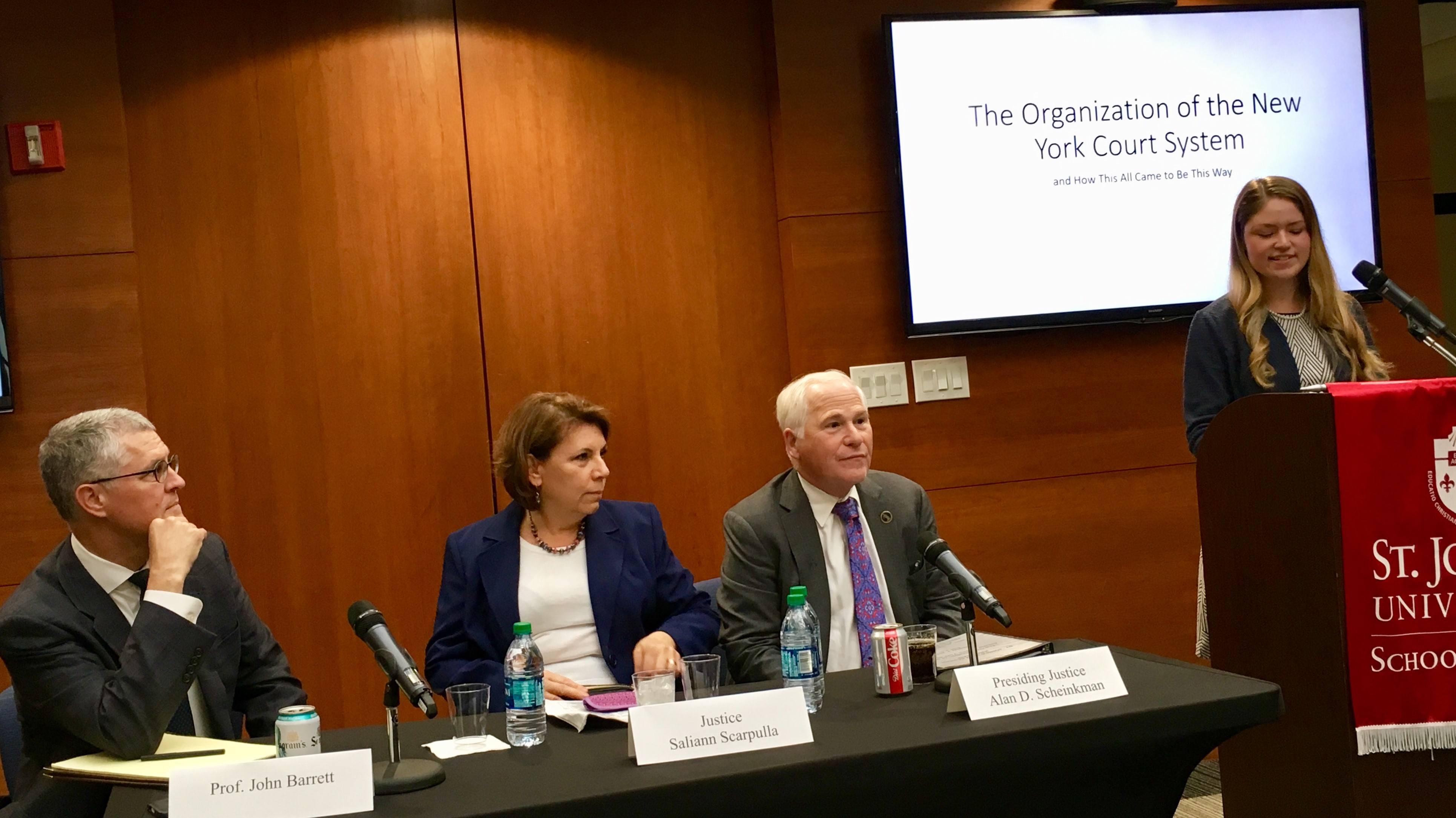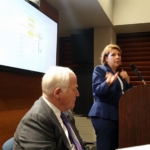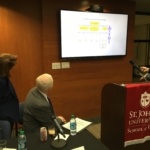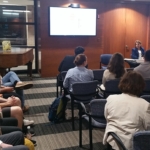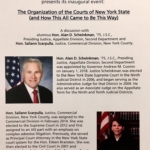This article was written by Danielle Stefanucci, St. John’s School of Law class of 2020 and Alumni Chair of the new St. John’s University School of Law Chapter of the Historical Society of the New York Courts. Special thanks to Mollie Galchus, President of the St. John’s Chapter and to Prof. John Q. Barrett, Chapter faculty advisor and Society Trustee, for all their help establishing the new Society Chapter at St. John’s!
Photo: Mollie Galchus introducing the evening’s speakers. Sitting (L-R): Prof. John Q. Barrett, Hon. Saliann Scarpulla, and Hon. Alan D. Scheinkman
On the evening of Tuesday, October 2nd, the St. John’s University School of Law Chapter of the Historical Society of the New York Courts held its inaugural event. The Organization of the New York Courts (and How It Came to be This Way) was held at the law school and drew first-year and upper-class students, professors, and community members. Two veteran New York State judges, Hon. Alan D. Scheinkman, ’75, Presiding Justice, Appellate Division, Second Department and Hon. Saliann Scarpulla, Justice, NYS Supreme Court, Commercial Division, New York County, headlined the event. Justice Scheinkman, a St. John’s School of Law alumnus, walked the gathered students and professors through the history of the statewide court system. He traced the origins of the New York Supreme Court back to 1691, to a court of general jurisdiction then called the Supreme Court of Judicature.
Answering the oft-asked first-year law student question of why New York calls its lowest court the Supreme Court, Justice Scheinkman claimed that “it’s New York—we make everything complicated.” He further detailed the mid-nineteenth century changes to the court system: the distinction between law and equity was abolished and the New York Court of Appeals established. Finally, Justice Scheinkman discussed the New York court system as it works today in practice: it is overseen by the Chief Judge of the State of New York, a position held by Hon. Janet DiFiore, ’81. The Court of Appeals judgeships were formerly elected positions, but in the 1970s they became appointed by the Governor through a nominating commission. Layers of administrative judges assist the Chief Judge in managing the court’s 18,000 employees; Justice Scheinkman himself served as an Administrative Judge in the Ninth District before being elevated to Presiding Justice of the Appellate Division.
Building on Justice Scheinkman’s presentation, Justice Scarpulla focused on the New York City court system, which differs slightly from the statewide system. As part of the First and Second Departments, which cover the Bronx and Manhattan and Queens, Brooklyn, Staten Island (and Long Island) respectively, Justice Scarpulla detailed how cases are dispersed throughout the different types of courts. The New York County Supreme Court hears felony cases and major civil cases, but misdemeanors are handled by the separate Criminal Court of the City of New York and smaller civil cases by the Civil Court of the City of New York. Further, Justice Scarpulla discussed how many city litigants actually appear in the specialized courts—Surrogate’s Court, Family Court, or Housing Court. Also unique to the City of New York, judges in New York City Criminal Court and Family Court are appointed by the mayor of New York. Justice Scarpulla herself was elected as a Civil Court judge, then a Supreme Court judge, and appointed to the Commercial Division in 2014. Some in the audience seemed dubious that the “Commercial Division” could offer much in the way of interesting cases, but Justice Scarpulla laughingly told her listeners that it is “not all dry,” intimating that she had cases involving several notable figures.
Following the presentations, faculty advisor Professor John Q. Barrett moderated a discussion where Justices Scheinkman and Scarpulla fielded student questions. The questions ranged from the propriety of election versus appointment to each of their paths to the judiciary. The two judges discussed the prominence of politics in both appointing and electing judges. In response to Justice Scheinkman’s claim that appointment removes politics from the equation, Justice Scarpulla countered that political influence is still present in the appointment process, but that appointment is less transparent than an election. In the context of her own election to the bench, she said that she was perfectly happy to let New Yorkers evaluate her as a judicial candidate.
The Justices also discussed how difficult it is to make any changes in the court system, both procedurally and institutionally. They further detailed the mechanism of change—either a State constitutional amendment or resolution passed by two consecutive legislatures. In response to a question about their pathways to the judiciary, both Justices briefly recounted their own career journeys. Justice Scheinkman talked about his time in politics and the positions he held as an attorney in both the public and private sectors before he decided to run for the Supreme Court. A native of Queens, Justice Scarpulla discussed her commercial litigation and in-house experiences in private practice and her transition to Civil Court. Both Justices assured students to keep their options open and take advantage of every opportunity that comes their way during the course of their careers.
The discussion was bookended by remarks from Mollie Galchus, ’19, the president of the new St. John’s chapter, who highlighted the Historical Society’s mission to preserve New York’s legal history and discussed the upcoming Historical Society events, both at the law school and the organization as a whole. At the conclusion of the presentation, students talked with the judges and asked questions over light refreshments. Overall, the event was highly informative and enjoyable. The students thank both Justice Scheinkman and Justice Scarpulla for taking the time to usher in a new local chapter of the Historical Society of the New York Courts.

